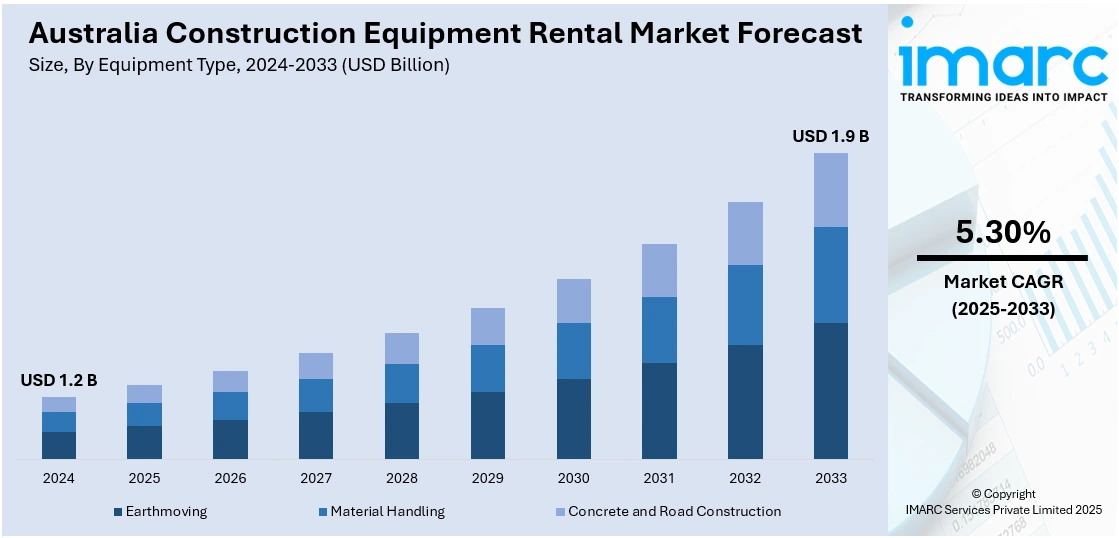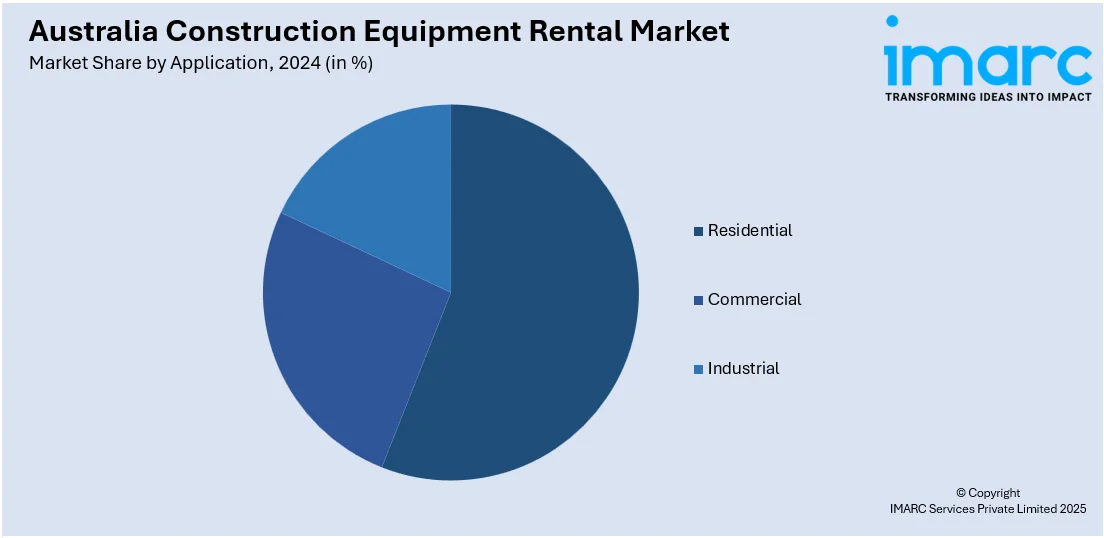
Australia Construction Equipment Rental Market Size, Share, Trends and Forecast by Equipment Type, Propulsion System, Application, and Region, 2025-2033
Australia Construction Equipment Rental Market Overview:
The Australia construction equipment rental market size reached USD 1.2 Billion in 2024. Looking forward, IMARC Group expects the market to reach USD 1.9 Billion by 2033, exhibiting a growth rate (CAGR) of 5.30% during 2025-2033. The market is expanding due to technological advancements and digital platforms that streamline equipment access and management, and major infrastructure projects, such as roads and renewable energy developments, which are increasing demand for heavy machinery. Renting equipment offers cost-effective flexibility, especially for small and medium enterprises, further fueling the Australia construction equipment rental market share.
|
Report Attribute
|
Key Statistics
|
|---|---|
|
Base Year
|
2024 |
|
Forecast Years
|
2025-2033
|
|
Historical Years
|
2019-2024
|
| Market Size in 2024 | USD 1.2 Billion |
| Market Forecast in 2033 | USD 1.9 Billion |
| Market Growth Rate 2025-2033 | 5.30% |
Australia Construction Equipment Rental Market Trends:
Surge in Infrastructure Development Projects
Australia’s growing investment in large-scale infrastructure, including roads, railways, and renewable energy facilities, is significantly boosting demand for construction equipment. Government initiatives like the National Infrastructure Construction Schedule (NICS) and projects under Infrastructure Australia stimulate short-term and long-term equipment needs. However, many contractors opt for rental services to manage cash flow while meeting tight project deadlines. Renting eliminates the upfront costs of purchasing heavy machinery and allows access to a wide fleet without long-term commitment. This is particularly appealing during multi-phase projects, where equipment needs may change frequently. As infrastructure development accelerates across both urban and regional areas, rental services offer the flexibility and scalability required to support fluctuating demand and efficient project execution.

To get more information on this market, Request Sample
Cost Efficiency and Operational Flexibility
Renting construction equipment allows businesses to reduce capital expenditure and maintain cash flow flexibility, critical factors in Australia’s dynamic construction sector. Small and medium enterprises (SMEs), which make up a significant portion of the industry, often find equipment rental more financially viable than outright purchases. Rentals also eliminate costs related to maintenance, storage, insurance, and depreciation. Moreover, rental providers offer the latest models with enhanced features, ensuring improved productivity without long-term ownership obligations. This model supports contractors working on short-duration or variable-scope projects, enabling them to match specific machinery to job requirements. In a market where demand can be seasonal or project-based, this flexibility drives widespread adoption of rental services as a strategic financial and operational decision, which further supports the Australia construction equipment rental market growth.
Technological Advancements and Digital Platforms
The integration of technology in construction equipment, such as GPS tracking, telematics, and IoT sensors, has enhanced the appeal of rentals. Australian rental companies now offer smart machinery that improves fuel efficiency, monitors performance, and ensures predictive maintenance. Digital platforms and apps have also made renting easier and faster by allowing users to browse equipment availability, compare rates, schedule deliveries, and track equipment usage in real time. These tech-enabled services reduce administrative burden and improve project planning. For contractors seeking efficiency, accountability, and transparency, such innovations make rentals the preferred option. Furthermore, sustainability-conscious firms favor newer, more efficient equipment available through rentals, helping meet environmental targets without long-term ownership costs. For instance, in November 2024, Hilti Australia and Kennards Hire unveiled a pioneering partnership in the hire industry, emphasizing innovative equipment while enhancing sustainability and circularity results in the construction and rental industries.
Australia Construction Equipment Rental Market Segmentation:
IMARC Group provides an analysis of the key trends in each segment of the market, along with forecasts at the country and regional levels for 2025-2033. Our report has categorized the market based on equipment type, propulsion system, and application.
Equipment Type Insights:
- Earthmoving
- Excavator
- Loader
- Backhoe
- Motor Grader
- Others
- Material Handling
- Crawler Crane
- Trailer-Mounted Crane
- Truck-Mounted Crane
- Concrete and Road Construction
The report has provided a detailed breakup and analysis of the market based on the equipment type. This includes earthmoving (excavator, loader, backhoe, motor grader, and others), material handling (crawler crane, trailer-mounted crane, and truck-mounted crane), and concrete and road construction.
Propulsion System Insights:
- Electric
- ICE
A detailed breakup and analysis of the market based on the propulsion system have also been provided in the report. This includes electric and ICE.
Application Insights:

- Residential
- Commercial
- Industrial
A detailed breakup and analysis of the market based on the application have also been provided in the report. This includes residential, commercial, and industrial.
Regional Insights:
- Australia Capital Territory & New South Wales
- Victoria & Tasmania
- Queensland
- Northern Territory & Southern Australia
- Western Australia
The report has also provided a comprehensive analysis of all the major regional markets, which include Australia Capital Territory & New South Wales, Victoria & Tasmania, Queensland, Northern Territory & Southern Australia, and Western Australia.
Competitive Landscape:
The market research report has also provided a comprehensive analysis of the competitive landscape. Competitive analysis such as market structure, key player positioning, top winning strategies, competitive dashboard, and company evaluation quadrant has been covered in the report. Also, detailed profiles of all major companies have been provided.
Australia Construction Equipment Rental Market Report Coverage:
| Report Features | Details |
|---|---|
| Base Year of the Analysis | 2024 |
| Historical Period | 2019-2024 |
| Forecast Period | 2025-2033 |
| Units | Billion USD |
| Scope of the Report | Exploration of Historical Trends and Market Outlook, Industry Catalysts and Challenges, Segment-Wise Historical and Future Market Assessment:
|
| Equipment Types Covered |
|
| Propulsion Systems Covered | Electric, ICE |
| Applications Covered | Residential, Commercial, Industrial |
| Regions Covered | Australia Capital Territory & New South Wales, Victoria & Tasmania, Queensland, Northern Territory & Southern Australia, Western Australia |
| Customization Scope | 10% Free Customization |
| Post-Sale Analyst Support | 10-12 Weeks |
| Delivery Format | PDF and Excel through Email (We can also provide the editable version of the report in PPT/Word format on special request) |
Key Questions Answered in This Report:
- How has the Australia construction equipment rental market performed so far and how will it perform in the coming years?
- What is the breakup of the Australia construction equipment rental market on the basis of equipment type?
- What is the breakup of the Australia construction equipment rental market on the basis of propulsion system?
- What is the breakup of the Australia construction equipment rental market on the basis of application?
- What is the breakup of the Australia construction equipment rental market on the basis of region?
- What are the various stages in the value chain of the Australia construction equipment rental market?
- What are the key driving factors and challenges in the Australia construction equipment rental market?
- What is the structure of the Australia construction equipment rental market and who are the key players?
- What is the degree of competition in the Australia construction equipment rental market?
Key Benefits for Stakeholders:
- IMARC’s industry report offers a comprehensive quantitative analysis of various market segments, historical and current market trends, market forecasts, and dynamics of the Australia construction equipment rental market from 2019-2033.
- The research report provides the latest information on the market drivers, challenges, and opportunities in the Australia construction equipment rental market.
- Porter's five forces analysis assist stakeholders in assessing the impact of new entrants, competitive rivalry, supplier power, buyer power, and the threat of substitution. It helps stakeholders to analyze the level of competition within the Australia construction equipment rental industry and its attractiveness.
- Competitive landscape allows stakeholders to understand their competitive environment and provides an insight into the current positions of key players in the market.
Need more help?
- Speak to our experienced analysts for insights on the current market scenarios.
- Include additional segments and countries to customize the report as per your requirement.
- Gain an unparalleled competitive advantage in your domain by understanding how to utilize the report and positively impacting your operations and revenue.
- For further assistance, please connect with our analysts.
 Request Customization
Request Customization
 Speak to an Analyst
Speak to an Analyst
 Request Brochure
Request Brochure
 Inquire Before Buying
Inquire Before Buying




.webp)




.webp)












